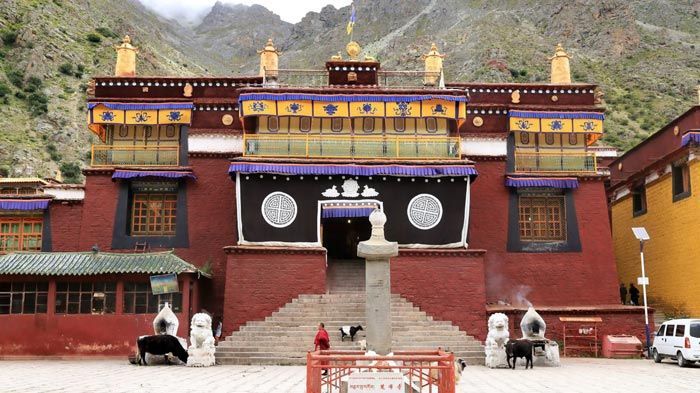 The Main Seat Of The Karmapas
The Main Seat Of The Karmapas
Tsurphu is the most important monastery of the Karma Kagyu lineage. It has been the main seat for the Karma Kagyud lineage and residence of all the successive reincarnations of the Gyalwang Karmapas since the inception of that line through the present.
The most renowned Tibetan buddhist system of reincarnate lama began from this very seat. In the Thirteenth Century, Karma Pakshi was recognized as the Second Karmapa, a reincarnation of the First Karmapa Düsum Khyenpa, thus commencing the institution of "tulku" (the manifestation or reincarnate lama) tradition in Tibet. Since then, the unbroken lineage of the Karma Kagyu has been passed down through successive Karmapas up to and including the present one, His Holiness the Seventeenth Gyalwang Karmapa, Ogyen Trinley Dorje.
Tsurphu is also well known for the peacefulness of its mountains and the favorable atmosphere of its valley, which has accommodated the great meditators, including the Karmapas, for many centuries. The Monastery was also renowned for the beauty and artistry of its traditional Tibetan architecture and decoration. Because the Monastery became the container for so many very precious relics over the centuries, it became over time an even more important source of blessings for practitioners.
Founding of Tsurphu
The First Karmapa, Düsum Khyenpa visited Tsurphu in 1159, at the age of fifty, and laid the foundation for the establishment of a seat there by making offerings to local protectors, just before he left for Kham, eastern Tibet.
In 1189, at the age of eighty, Düsum Khyenpa returned to Tsurphu and founded his main seat, known as the "earthly abode of the sacred place of the heart (or mind)", in the valley of Tölung in central part of Tibet. This monastery was to grow into a place in which over one thousand monks practiced. Since this time, Tsurphu has been the main seat of the successive manifestations of the line of the Karmapas, and of the Karma Kagyu lineage.
Further development
Tsurphu was further developed during the Second Karmapa, Karma Pakshi, who also built the most renowned buddha statue called Lhachen Zamling Gyen - the great deity, the ornament of the world. Since then, Tsurphu has flourished continuously during different incarnations of the Karmapas for over eight hundred years. Over the centuries, numerous buildings were constructed at the monastery, and Tsurphu grew into a magnificent complex of many institutions, all still centered around the area of the original shrine built by the First Karmapa, Düsum Khyenpa.
The whereabouts
Tsurphu Monastery is located in the northwest part of Tolung valley (now under Tolung Dechen Shen, the County of Lhasa Municipality) about 70 kilometers (about 44 miles) from the capital city of Lhasa. Its elevation is around 14,000 feet or 4,300 meters above the sea level.
The main shrine hall and the monastery is built in the middle of the valley near the Tsurphu River, facing south, and is surrounded by high mountains. A number of other reliquary shrines of the previous Karmapas, deity shrines, monastic quarters for monks' residences, meditation halls, printing house, offices, and the Karmapa's summer residence, are built around the main temple. Tsurphu also was the home for two large libraries enshrining the sutras, tantras, instructions, collected works of all great masters of the four school, Tibetan literature, and, most important of all, the writings of the all the Karmapas and their disciples.
Behind the complex rises the majestic mountain, known as the "Thukje Chenpo" (the great compassionate one), the great bodhisattva of compassion, Avalokiteshvara; in front is the mountain named "Mahakala" (the great black one), a protector of the Karma Kagyu lineage; and in the middle of the valley was the central mountain known as "Maitreya" (the loving protector), the great bodhisattva of loving kindness.
A three-year-retreat center is located at a higher level on the mountain behind the monastery. Nearby also exist many other small individual retreat houses where many of the Karmapas engaged in retreat practices.
Tsurphu Valley
Behind Tsurphu Monastery, another beautiful monastery was built,known as the "Chogar-gong," which became the main seat for the incarnations of Gyaltsab Rinpoches. On the right hand side of the monastery, there were two small monasteries and shrines, which are known as the "Dra-tshang" and "Zuri."
The protector's shrine for Gyang-tsen or Gyang-je, a local protector, is built in a rocky slope on the right hand side of the monastery and the shrine for Mahakali, Palden Lhamo, another famous Karma Kagyu protector, was built on the mountain slope of the left hand side of the monastery. In the front of the monastery, there is the protector's shrine of Khanak Dorje Gyalpo, nearby a spring.






